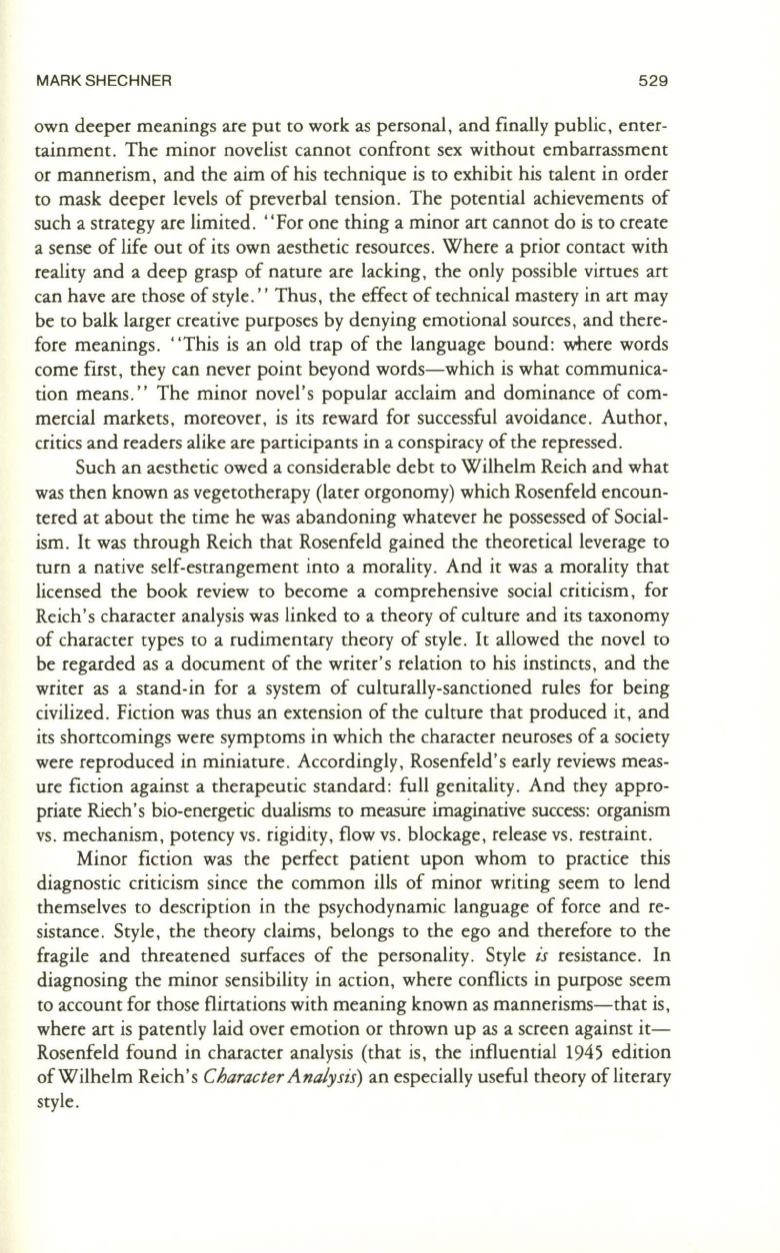
MARK SHECHNER
529
own deeper meanings are put to work as personal, and finally public, enter–
tainment. The minor novelist cannot confront sex without embarrassment
or mannerism, and the aim of his technique is to exhibit his talent in order
to mask deeper levels of preverbal tension. The potential achievements of
such a strategy are limited . " For one thing a minor art cannot do
is
to create
a sense of life out of its own aesthetic resources. Where a prior contact with
reality and a deep grasp of nature are lacking, the only possible virtues art
can have are those of style ." Thus , the effect of technical mastery in art may
be to balk larger creative purposes by denying emotional sources, and there–
fore meanings. "This is an old trap of the language bound: where words
come first, they can never point beyond words-which is what communica–
tion means." The minor novel's popular acclaim and dominance of com–
mercial markets, moreover, is its reward for successful avoidance. Author,
critics and readers alike are participants in a conspiracy of the repressed.
Such an aesthetic owed a considerable debt to Wilhelm Reich and what
was then known as vegetotherapy (later orgonomy) which Rosenfeld encoun–
tered at about the time he was abandoning whatever he possessed of Social–
ism.
It
was through Reich that Rosenfeld gained the theoretical leverage to
turn a native self-estrangement into a morality. And it was a morality that
licensed the book review to become a comprehensive social criticism, for
Reich's character analysis was linked to a theory of culture and its taxonomy
of character types to a rudimentary theory of style.
It
allowed the novel to
be regarded as a document of the writer's relation to his instincts, and the
writer as a stand-in for a system of culturally-sanctioned rules for being
civilized. Fiction was thus an extension of the culture that produced it, and
its shortcomings were symptoms in which the character neuroses of a society
were reproduced in miniarure. Accordingly, Rosenfeld's early reviews meas–
ure fiction against a therapeutic standard: full genitality. And they appro–
priate Riech's bio-energetic dualisms
to
measUre imaginative success: organism
vs. mechanism, potency vs. rigidity, flow vs. blockage, release vs. restraint.
Minor fiction was the perfect patient upon whom to practice this
diagnostic criticism since the common ills of minor writing seem to lend
themselves to description in the psychodynamic language of force and re–
sistance. Style, the theory claims, belongs to the ego and therefore to the
fragile and threatened surfaces of the personality. Style
is
resistance . In
diagnosing the minor sensibility in action, where conflicts in purpose seem
to account for those flirtations with meaning known as mannerisms-that is,
where art is patently laid over emotion or thrown up as a screen against it–
Rosenfeld found in character analysis (that is, the influential 1945 edition
ofWilhelm Reich's
Character Analysis)
an especially useful theory of literary
style.


